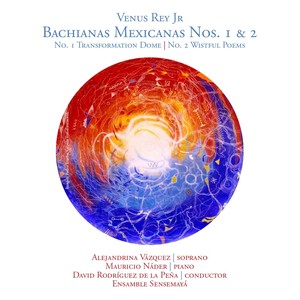
Bachianas Mexicanas Nos. 1 & 2
- 流派:Classical 古典
- 语种:英语
- 发行时间:2016-04-15
- 类型:录音室专辑
- 歌曲
- 时长
-
Bachiana Mexicana No. 2
-
Bachiana Mexicana No. 2: 5 Finale
-
Bachiana Mexicana No. 1
-
Bachiana Mexicana No. 1: 5. Finale
简介
It is very likely that music lovers might be familiar with Heitor Villa-Lobos’ Bachianas Brasileiras. In this works the Brazilian composer uses elements from baroque music, and thus he gives homage to Johann Sebastian Bach. On the other hand he uses elements from Brazil’s folk music. The result is an amazing series of works which stand among the best ever written in the Latin-American repertoire. Venus Rey Jr follows this model and starts his own series of Bachianas Mexicanas. Bachiana Mexicana No. 1 Transformation Dome (2015) This Bachiana Mexicana is scored for flute, horn in F, bassoon, two violins, viola, cello, double bass and soprano soloist and was composed in just five days by Mexican artist Venus Rey Jr. It was commissioned by the CISS (Inter-American Conference of Social Security) for the Inauguration of the great cupola of the main auditory. This impressive cupola was painted by Pedro Trueba: a superb 500 square meter fresco that can be admired in Mexico City. The music was first performed on April 17th 2015 by the Sensemayá Ensemble and soprano Alejandrina Vázquez. The work has five movements: I. q = 120 bpm II. Vocalise. Adagio III. Allegro IV. Vocalise. Allegretto V. Finale. Vocalise. q = 120 bpm Bachiana Mexicana No. 2 Wistful Poems This Bachiana is scored for 16 musicians: flute, horn in F, bassoon, two percussionist, timpani, piano, soprano soloist, three violins, two violas, two celli and double bass and was composed by Venus Rey Jr between November 2015 and January 2016. The music was first performed on February 27th in Mexico City by the Sensemayá Ensemble and soprano Alejandrina Vázquez. This work was written in memory of the late Zaeth Ritter, a very close friend of the composer. Zaeth Ritter was a very gifted conductor. Venus Rey Jr was in shock when he knew about Zaeth’s death, and so he decided to write a work for her. This work had also to be a deep meditation about death and the meaning of life. The composer chose five poetic texts and started to work in mid November 2015. He finished the first week of 2016. The composer uses five poetical texts: Verrà la morte e avrà I tuoi occhi (Death shall come and shall have your eyes), by Italian poet Cesare Pavese; Rex Tremendæ, a Liturgical text form the Middle Ages; A morte chega cedo (Death arrives soon), by Portuguese poet Fernando Pessoa; Viaje fuera del cuerpo (A journey out of the body), by Venus Rey Jr; and Químera (Chimera), by Zaeth Ritter.

